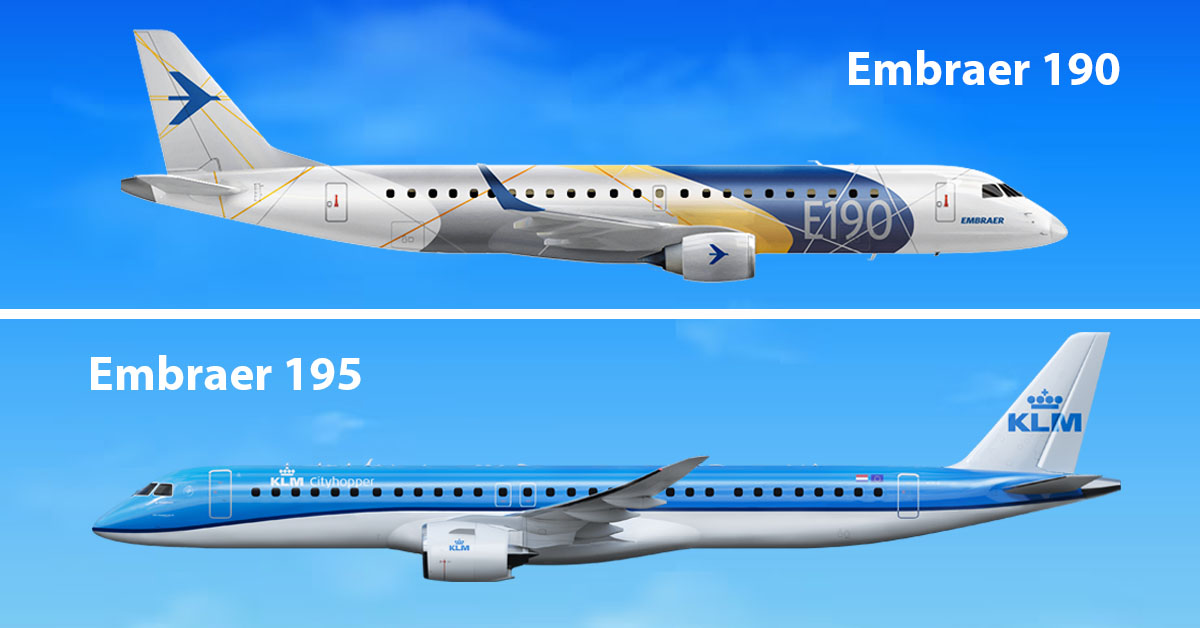In the realm of regional jets, the Embraer 190 vs 195 stand out as two significant models within the E-Jet family. While they share many similarities, there are distinct differences that set them apart, making each suitable for different operational needs. This comprehensive blog post aims to delve into a detailed comparison of the Embraer 190 and 195, focusing on their design, performance, and role in airline fleets.
Embraer 190 vs 195

The Embraer E190 vs E195 have some key differences in their capabilities and features. One noticeable difference is their passenger capacity and seating configurations. The E195 generally offers more seats compared to the E190, with various options for legroom. For instance, the E190 might have 96 seats in dual class or 100 seats in single class, while the E195 could have 100 seats in dual class or 116 seats in single class. Both planes have the same maximum speed and can reach the same altitude, but the E195 typically takes a bit longer to climb to its cruising altitude. Also, it needs a slightly longer runway for takeoff compared to the E190. Despite these differences, both planes have similar ranges, meaning they can cover similar distances without needing to refuel. Overall, the E195 is a slightly larger aircraft with a bit more seating capacity compared to the E190. Check out our comparison Embraer 190 vs Airbus A320 of the to see how they differ.
Here’s a comparison table of the Embraer E190 vs E195 based on the specifications provided:
| Specification | Embraer E190 | Embraer E195 |
|---|---|---|
| Maximum Take Off Weight | 51,800 kg / 114,199 lb | 52,290 kg / 115,280 lb |
| Maximum Landing Weight | 44,000 kg / 97,003 lb | 45,800 kg / 100,972 lb |
| Maximum Payload | 13,047 kg / 28,764 lb | 13,917 kg / 30,682 lb |
| Maximum Usable Fuel^ | 12,971 kg / 28,596 lb | 12,971 kg / 28,596 lb |
| Typical Seat Capacity | ||
| Dual Class | 96 seats (8 @ 38”, 88 @ 31” pitch) | 100 seats (12 @ 42”, 88 @ 33” pitch) |
| Single Class | 100 seats @ 32” | 31” pitch |
| 124 seats @ 31” | ||
| Performance | ||
| Max Cruise Speed | M 0.82 | M 0.82 |
| Time to Climb to FL350* | 16 min | 18 min |
| Takeoff Field Length** | 1,267 m / 4,157 ft | 1,432 m / 4,698 ft |
| 2,100 m / 6,890 ft | 2,179 m / 7,149 ft | |
| Landing Field Length**** | 1,244 m / 4,081 ft | 1,275 m / 4,183 ft |
| Service Ceiling | 41,000 ft | 41,000 ft |
| Range* | 2,450 nm / 4,537 km | 2,300 nm / 4,260 km |
Embraer 195

The Embraer E195 is the largest member of the E-Jet family, designed to bridge the gap between regional and mainline aircraft. With its enhanced economics compared to the E190, the E195 is particularly appealing to low-cost operators. Offering improved efficiencies, performance, and passenger comfort, the E195 takes the renowned features of the E-Jet to the next level. Its spacious cabin can accommodate up to 124 passengers in a single-class configuration, ensuring a comfortable journey for travelers. With a maximum takeoff weight of 52,290 kg and a range of 2,300 nautical miles, the E195 is well-equipped for both short-haul and medium-haul flights. Whether it’s soaring through the skies or navigating busy airports, the Embraer E195 continues to redefine the regional jet experience.
Embraer 190

The Embraer E190 was launched to address a gap in the market for a regional aircraft with capabilities similar to mainline planes. Offering one of the most spacious interiors among single-aisle aircraft, it combines comfort with impressive economics. Whether flying short hops or longer routes, the E190 is versatile and efficient. With a maximum takeoff weight of 51,800 kg and a range of 2,450 nautical miles, it is well-suited for various missions. Additionally, Embraer has introduced a new variant, the Embraer E190 E2, with even higher performance capacity and range. As the first member of the E-Jet E2 family, the E190-E2 is designed to excel in performance while maintaining comfort and sustainable profitability. With a maximum takeoff weight of 56,400 kg and a range of 2,850 nautical miles, it opens up new markets and offers enhanced capabilities for airlines worldwide.
Design and Comfort
Embraer 190: The Embraer 190 is designed with a focus on passenger comfort and efficiency. It typically features a 2-2 seating configuration in economy class, eliminating the middle seat for enhanced passenger comfort. The aircraft is tailored to accommodate approximately 96 to 114 passengers, providing a balance between capacity and comfort.
Embraer 195: The Embraer 195, a stretched version of the E190, offers a larger cabin space. This model also maintains the 2-2 seating arrangement but can seat about 108 to 122 passengers. The added length of the E195 allows for more rows of seats, catering to airlines that require higher capacity without compromising on passenger comfort.
Performance and Range
Embraer 190: The E190 is known for its versatility and efficiency. With a range of about 2,800 nautical miles, it is well-suited for both short-haul and medium-haul routes. The aircraft’s performance makes it ideal for operations at smaller airports and in various geographical conditions.
Embraer 195: The E195, while similar in range to the E190, offers enhanced performance for routes that demand higher passenger capacity. The aircraft’s range of approximately 2,600 nautical miles makes it a strong contender for medium-haul routes, balancing capacity and range effectively.
Economic Considerations
Embraer 190: The E190, with its moderate size, tends to have lower operational costs compared to larger jets, making it a cost-effective option for airlines focusing on medium-density routes. Its fuel efficiency and lower maintenance costs contribute to its economic viability.
Embraer 195: The E195, due to its larger size and capacity, might incur slightly higher operational costs. However, the potential for increased revenue due to higher passenger capacity can offset these costs, making it suitable for more densely populated routes.
Role in Airline Fleets
Embraer 190: The E190 is often utilized by regional carriers and major airlines for medium-density routes. Its flexibility and efficiency make it an excellent choice for expanding regional networks and connecting smaller cities to larger hubs.
Embraer 195: The E195 is ideal for airlines looking to increase capacity on popular regional routes without transitioning to larger narrow-body aircraft. Its larger size and capacity make it suitable for higher-density routes and peak travel times.
FAQs
- What distinguishes the Embraer 190 from the 195?
- The main distinction lies in their size and capacity. The E190 seats 96-114 passengers, while the E195 can accommodate 108-122 passengers, making the E195 a better option for higher-density routes.
- Is there a significant difference in range between the two aircraft?
- The range is similar, with the E190 covering about 2,800 nautical miles and the E195 around 2,600 nautical miles, making both suitable for medium-haul routes.
- Which aircraft is more cost-effective for airlines?
- The E190 tends to be more cost-effective for medium-density routes due to its lower operational costs, while the E195 can be more profitable on busier routes despite slightly higher costs.
- Can both aircraft operate in smaller regional airports?
- Yes, both the E190 and E195 are designed to operate efficiently in smaller airports, making them versatile for various route networks.
- Which aircraft should airlines choose for expanding their regional network?
- Airlines focusing on medium-density routes might prefer the E190 for its cost-effectiveness, while those looking to serve higher-density routes may opt for the E195 for its increased capacity.



